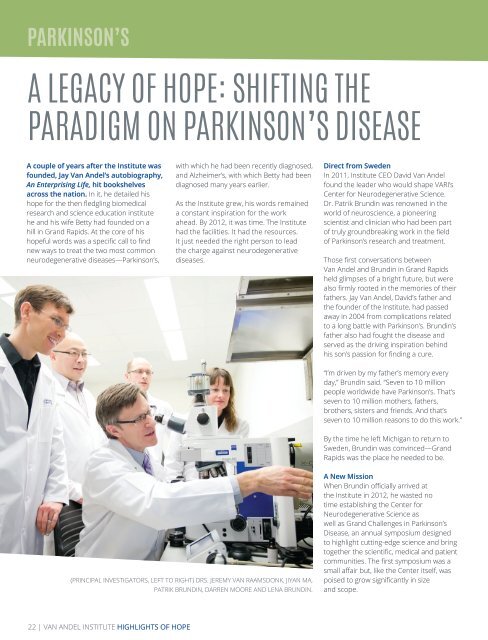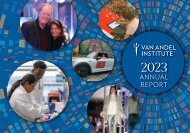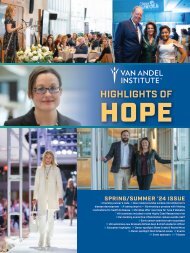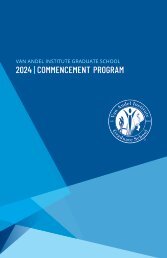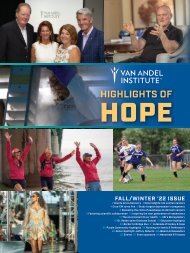Highlights of Hope 20th Anniversary
You also want an ePaper? Increase the reach of your titles
YUMPU automatically turns print PDFs into web optimized ePapers that Google loves.
PARKINSON’S<br />
PLEASE ADD A BANNER TO THIS PAGE<br />
A LEGACY OF HOPE: SHIFTING THE<br />
PARADIGM ON PARKINSON’S DISEASE<br />
A couple <strong>of</strong> years after the Institute was<br />
founded, Jay Van Andel’s autobiography,<br />
An Enterprising Life, hit bookshelves<br />
across the nation. In it, he detailed his<br />
hope for the then fledgling biomedical<br />
research and science education institute<br />
he and his wife Betty had founded on a<br />
hill in Grand Rapids. At the core <strong>of</strong> his<br />
hopeful words was a specific call to find<br />
new ways to treat the two most common<br />
neurodegenerative diseases—Parkinson’s,<br />
with which he had been recently diagnosed,<br />
and Alzheimer’s, with which Betty had been<br />
diagnosed many years earlier.<br />
As the Institute grew, his words remained<br />
a constant inspiration for the work<br />
ahead. By 2012, it was time. The Institute<br />
had the facilities. It had the resources.<br />
It just needed the right person to lead<br />
the charge against neurodegenerative<br />
diseases.<br />
(PRINCIPAL INVESTIGATORS, LEFT TO RIGHT) DRS. JEREMY VAN RAAMSDONK, JIYAN MA,<br />
PATRIK BRUNDIN, DARREN MOORE AND LENA BRUNDIN.<br />
Direct from Sweden<br />
In 2011, Institute CEO David Van Andel<br />
found the leader who would shape VARI’s<br />
Center for Neurodegenerative Science.<br />
Dr. Patrik Brundin was renowned in the<br />
world <strong>of</strong> neuroscience, a pioneering<br />
scientist and clinician who had been part<br />
<strong>of</strong> truly groundbreaking work in the field<br />
<strong>of</strong> Parkinson’s research and treatment.<br />
Those first conversations between<br />
Van Andel and Brundin in Grand Rapids<br />
held glimpses <strong>of</strong> a bright future, but were<br />
also firmly rooted in the memories <strong>of</strong> their<br />
fathers. Jay Van Andel, David’s father and<br />
the founder <strong>of</strong> the Institute, had passed<br />
away in 2004 from complications related<br />
to a long battle with Parkinson’s. Brundin’s<br />
father also had fought the disease and<br />
served as the driving inspiration behind<br />
his son’s passion for finding a cure.<br />
“I’m driven by my father’s memory every<br />
day,” Brundin said. “Seven to 10 million<br />
people worldwide have Parkinson’s. That’s<br />
seven to 10 million mothers, fathers,<br />
brothers, sisters and friends. And that’s<br />
seven to 10 million reasons to do this work.”<br />
By the time he left Michigan to return to<br />
Sweden, Brundin was convinced—Grand<br />
Rapids was the place he needed to be.<br />
A New Mission<br />
When Brundin <strong>of</strong>ficially arrived at<br />
the Institute in 2012, he wasted no<br />
time establishing the Center for<br />
Neurodegenerative Science as<br />
well as Grand Challenges in Parkinson’s<br />
Disease, an annual symposium designed<br />
to highlight cutting-edge science and bring<br />
together the scientific, medical and patient<br />
communities. The first symposium was a<br />
small affair but, like the Center itself, was<br />
poised to grow significantly in size<br />
and scope.<br />
By early 2016, just a few short years after<br />
its creation, the Center was growing rapidly,<br />
having eight exceptional, established<br />
investigators and rising talent. In much the<br />
same way, the field <strong>of</strong> Parkinson’s research<br />
also hit an inflection point, one bolstered<br />
by scientific discoveries and a dedicated<br />
community <strong>of</strong> people with Parkinson’s and<br />
their advocates.<br />
Answering the Call<br />
Two years earlier, a crowd <strong>of</strong> more than<br />
325 people—scientists, clinicians, students,<br />
people with Parkinson’s and advocates—sat<br />
in awed silence in the Institute’s Tomatis<br />
Auditorium during Grand Challenges. On<br />
stage, Tom Isaacs, co-founder <strong>of</strong> the UK<br />
research charity The Cure Parkinson’s Trust<br />
and one <strong>of</strong> the community’s most influential<br />
and well-respected voices, gave a powerful<br />
speech outlining the unmet needs <strong>of</strong> the<br />
Parkinson’s community: more definitive<br />
diagnosis, improved care and therapies that<br />
change the course <strong>of</strong> the disease.<br />
“We’re constantly learning<br />
something new—the pace is<br />
absolutely astounding. Each discovery is<br />
another step closer to a future in which<br />
Parkinson’s no longer robs people<br />
<strong>of</strong> their golden years. There’s a<br />
big shift coming—we can<br />
see it on the horizon.”<br />
– Dr. Patrik Brundin<br />
“Our sense <strong>of</strong> urgency is intense,” Isaacs<br />
said. “I think the world <strong>of</strong> Parkinson’s is on<br />
the verge <strong>of</strong> a seismic shift for the better.”<br />
His speech came at an auspicious<br />
time. For more than 50 years, treating<br />
Parkinson’s looked more or less the<br />
same and had focused on mitigating<br />
symptoms rather than addressing the<br />
actual underlying causes <strong>of</strong> the disease.<br />
But science has been far from idle during<br />
this time; in fact, it has been booming.<br />
The Right Place, the Right Time<br />
More is known about Parkinson’s now than<br />
THE CURE PARKINSON’S TRUST CO-FOUNDER, TOM ISAACS, ADDRESSES THE<br />
CROWD AT THE 2014 GRAND CHALLENGES IN PARKINSON’S DISEASE SYMPOSIUM.<br />
ever before. Once thought to be strictly a<br />
movement disorder, scientists have learned<br />
that it can include a host <strong>of</strong> non-motor<br />
symptoms such as depression, loss <strong>of</strong><br />
sense <strong>of</strong> smell and cognitive impairment.<br />
And they’ve learned how it spreads from<br />
cell to cell in the brain, slowly killing neurons<br />
that produce dopamine, a chemical<br />
required for smooth movement.<br />
These findings and other insights into<br />
the underpinnings <strong>of</strong> Parkinson’s didn’t<br />
happen in a vacuum; rather, they required<br />
a multidisciplinary and collaborative<br />
approach, both <strong>of</strong> which are at the heart<br />
<strong>of</strong> the Center’s philosophy. By recruiting<br />
exceptional scientists from across the<br />
spectrum <strong>of</strong> Parkinson’s research, from<br />
genetics and epigenetics to pathology to<br />
therapeutic development, VARI is building<br />
a critical mass <strong>of</strong> expertise, ensuring<br />
a scientifically strong and innovative<br />
environment. The benefits <strong>of</strong> this work are<br />
broad, <strong>of</strong>ten spilling over to inform research<br />
on other neurodegenerative diseases such<br />
as Alzheimer’s and multiple system atrophy.<br />
At the same time, VARI scientists reach<br />
beyond Grand Rapids to collaborate with<br />
colleagues around the world, delving<br />
deeper into the mechanisms behind<br />
Parkinson's in an effort to translate their<br />
findings into new ways <strong>of</strong> definitively<br />
diagnosing the disease, slowing or stopping<br />
progress, and repairing the damage. Their<br />
ultimate goal is to improve the quality <strong>of</strong> life<br />
for people with Parkinson’s. They’re getting<br />
closer; together with The Cure Parkinson’s<br />
Trust, VARI is finding new uses for existing<br />
drugs approved to treat other diseases<br />
that may also treat Parkinson’s. Some <strong>of</strong><br />
these efforts have already made it into the<br />
crucial clinical trial phase, and others are<br />
well on their way.<br />
The Center and its efforts to move therapies<br />
to the clinic continue to grow—plans call for<br />
the recruitment <strong>of</strong> a neurologist to establish<br />
VARI-supported clinical trials where Jay and<br />
Betty Van Andel’s dream began, in Grand<br />
Rapids. With every step, their vision—the<br />
Institute’s vision—to positively impact<br />
human health is becoming a reality.<br />
“We’re constantly learning something<br />
new—the pace is absolutely astounding,”<br />
Brundin said. “Each discovery is another<br />
step closer to a future in which Parkinson’s<br />
no longer robs people <strong>of</strong> their golden years.<br />
There’s a big shift coming—we can see it on<br />
the horizon.”<br />
22 | VAN ANDEL INSTITUTE HIGHLIGHTS OF HOPE<br />
VAN ANDEL INSTITUTE HIGHLIGHTS OF HOPE | 23


